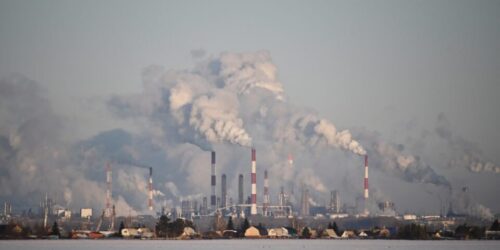With Russian troops massing on Ukraine’s border, and President Biden urging Russia’s Vladimir Putin not to invade, the geopolitics of Russian natural gas are growing increasingly intolerable. European gas imports are a mainstay of cash for Putin’s regime, with over one-third of Kremlin funding coming directly from oil and gas revenue, even as Russia increases repression at home, attempts to undermine democratic elections abroad and continues to use its gas as a geopolitical weapon against Europe.
If that weren’t enough, Russia is the world’s largest emitter of methane, a super climate pollutant whose mitigation is now crucial to global climate change efforts. The EU gets more than 25 percent of its total gas and half its gas imports from Russia’s leaky, antiquated gas production system with emissions of methane eight times higher than EU domestic gas. With methane leaks of at least 5 to 7 percent, the EU is addicted to Russian gas that increases warming twice as much as the coal it’s meant to replace.
The U.S. and EU need to develop more strategic and long-term plans to limit the geopolitical and climate nightmare that is Russian gas. The EU, as the world’s largest gas importer, and the U.S., as a growing exporter of gas, are in position to reduce reliance on Russian gas and bring about deep emissions reductions if they pursue complementary gas regulations and other policies, together. A new report from the Progressive Policy Institute recommends specific policies to help the EU and U.S. limit the security and climate costs of Russian gas, including:
Requiring accurate reporting of methane emissions from gas imports into the EU, and eventually regulating methane from gas imports
Expanding EU renewable energy production and electricity storage capacity
Increasing liquefied natural gas (LNG) imports from the U.S. and other sources with lower methane emissions, and helping Ukraine clean up and export its gas
Preventing the Nord Stream 2 pipeline from becoming operational through German, U.S. and EU actions
Laying the groundwork for long-term hydrogen power created from both renewable energy and gas while utilizing the natural gas distribution system
If implemented carefully over time, these measures have the ability to limit energy prices along with emissions, so they can gain and maintain long-term political support. Most importantly, such measures can reduce Russia’s leverage to use restrictions in natural gas supplies as a threat against Europe while also limiting methane emissions and decreasing Kremlin funding.
The U.S. can play a huge role here. Last month, Biden announced stringent domestic methane regulations on oil and gas production. These efforts to “demethanize” U.S. gas can greatly increase the EU’s openness to additional American LNG exports. To increase this prospect, the U.S. should consider harmonizing its methane regulations with those in the EU to increase lower methane LNG exports to Europe.
Somewhat surprisingly, much of the U.S. oil and gas industry has chosen not to oppose the new methane regulations, in part because about half of lifecycle methane leaks can be prevented at net-zero cost to industry and estimates are that 70 percent of methane can be captured with existing technology by 2025. But many in U.S. industry also recognize that cutting emissions will be necessary for gas to compete in an increasingly climate-constrained energy system.
Getting the world’s largest gas exporters with high methane leaks to clean up their gas, however, will be far harder, especially since much of it comes from secretive and autocratic hydrocarbon-states like Russia, Iran and Qatar. A recent investigation by the Washington Post and new methane detection technologies have found, as long suspected, that Russia has deliberately underestimated and lied about its emissions for decades.
A draft bill has emerged in the EU Parliament that would require domestic sources of gas to accurately report their methane emissions, and would impose regulations reducing methane from gas in future years. But to truly limit methane emissions, the EU, as the world’s largest gas importer, must also regulate emissions from gas imports. Whether Russia can credibly measure and accurately report its methane emissions, let alone prove they are cutting them, is entirely unclear. But U.S. and other lower-methane LNG sources, including from Ukraine, along with greater domestic EU clean energy, can increasingly make up the difference over time.
Some EU and U.S. climate activists insist natural gas should be completely phased out immediately, but most credible analysis finds that gas will be crucial to the clean energy transition in the EU, U.S. and globally over the next few decades. Low-methane gas can help phase out higher emitting coal, which still generates 15 percent of power even in Europe, and provides on-demand electricity supply needed to cover for intermittent renewable power.
Russian gas is a geopolitical and climate disaster that helps sustain Putin’s malign regime. But the EU and U.S. and their allies can together take actions to limit the adverse impacts of Russian gas in the near-term while setting in place longer-term options for cleaner, more secure energy sources.





